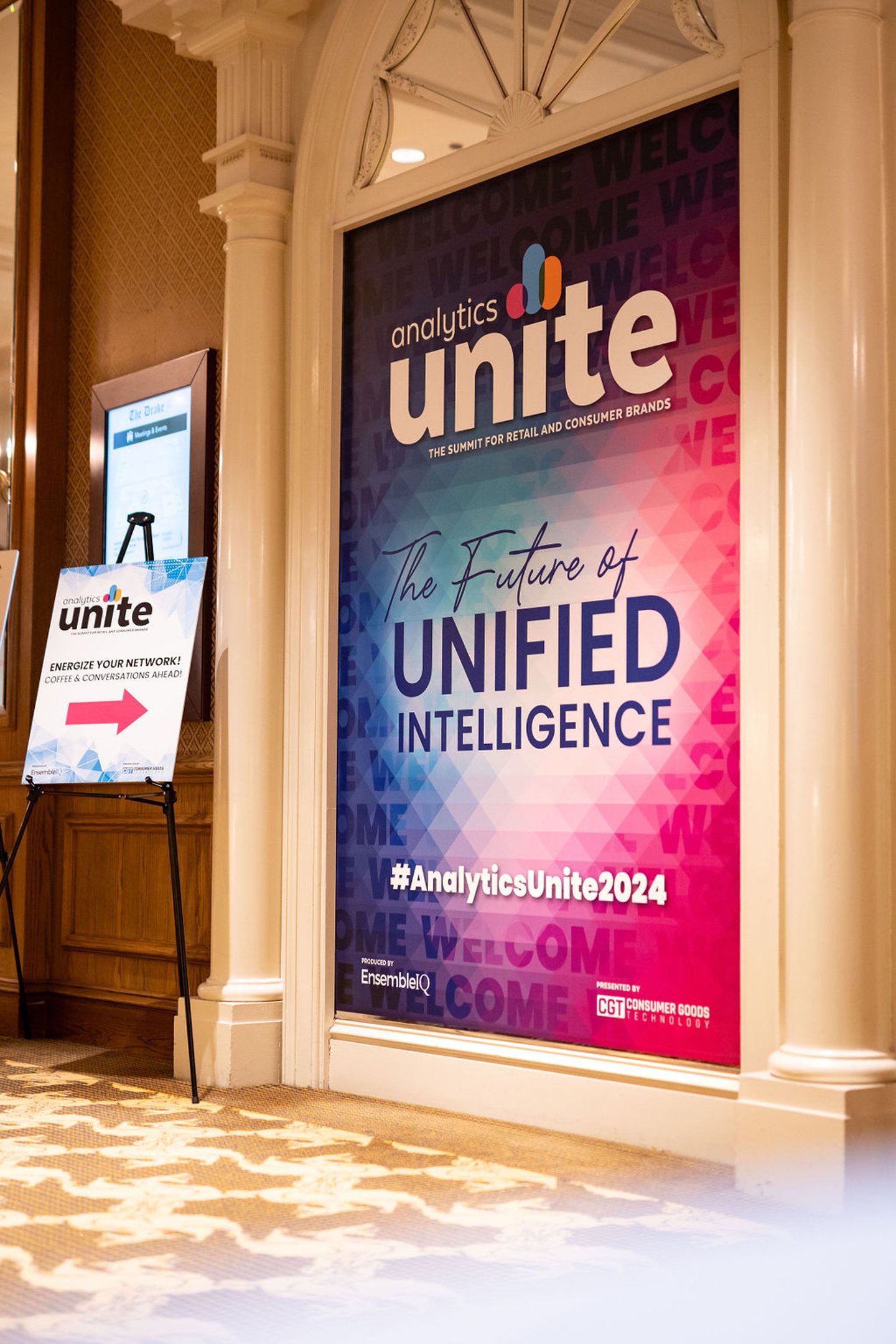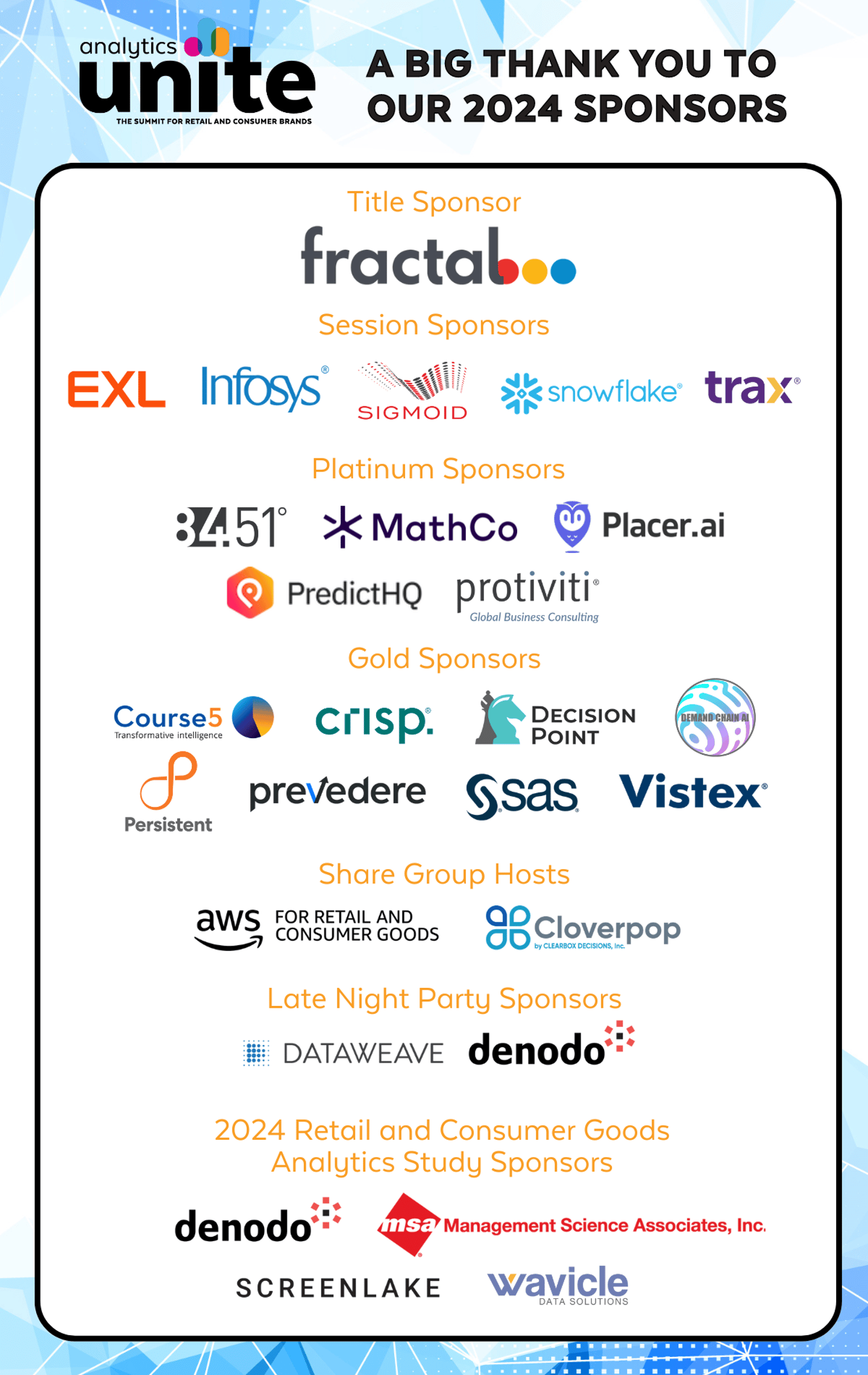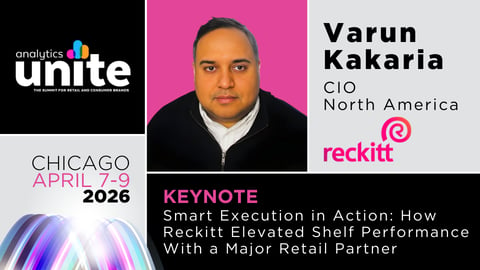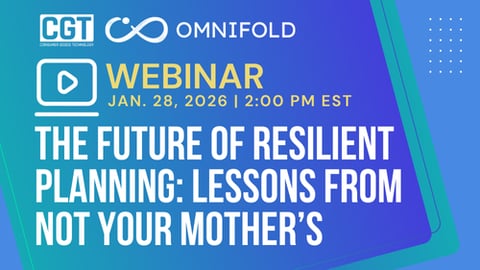Analytics Unite: Uncovering the Keys to Unified Intelligence
It was a banner year for Analytics Unite. Highly attended with an extremely engaged audience, the event welcomed some of the most influential voices from iconic consumer goods and retail companies.
From the successes, challenges, and innovations discussed over three action-packed days in May at the Drake Hotel in Chicago emerged new connections, innovative ideas, and renewed motivation.
The theme of unified intelligence created a foundation for initiating conversations around tackling one of the most pressing challenges across both industries: making the most of analytics to drive innovation through clean, collaborative data.
Read on for key takeaways from the event, highlighting all sessions and linking to expanded coverage.
Opening Session: How to Automate Supply Chain Processes With Legacy Tie-Downs
There are two elements that consumers crave and that help CPG and retail businesses build a competitive advantage: speed and convenience.
Ashish Bharara, supply chain director with Amazon, has seen this across his career, which includes time at companies like Walmart and Advanced Auto Parts. During an interactive session that kicked off the event, Bharara shared strategies for scaling these even for companies bogged down by legacy systems.
As supply chain processes grow ever more complex, he said, companies need to get more granular with their data, set up a large amount of storage and computes, and set up simulations and guardrails.
Learn more and get details from a supply chain automation project he led at Advanced Auto Parts.
Workshops & Share Groups
Workshop: Building Analytics Strategies for Unified Intelligence Excellence
In this interactive workshop, attendees were first taken on a short walk down memory lane by Iwao Fusillo, global head of data and analytics for PepsiCo e-commerce, as he drew parallels between his past experiences in the financial sector, sports and media, manufacturing, and retail/CPG industries. Things quickly moved to the future, as he walked through some of the most impactful retail technologies today, including composable commerce and (naturally) artificial intelligence.
After his presentation, the busy room buzzed with conversation as attendees worked on a series of exercises, led by Sangeetha Chandru, EXL SVP and global practice head for CPG and retail, and her team that explored the challenges, opportunities, and pathways to growth surrounding supply chain, marketing, data engineering, connected commerce, and more.
While opinions and experiences ranged the gamut, the need for quality data and strong infrastructures was a common thread throughout the tables.
Share Group: Driving Innovation Across the Value Chain - Where and How to Invest for Big Results
Analytics Unite attendees took a deep dive into the inner workings of generative AI in the consumer goods and retail industry thanks to dual presentations this share group.
To kick things off, Aparna Galiasso, head, North America CPG GTM strategy at AWS, shared trends into how retail and CPG AWS customers and consumers are leveraging generative AI for personalization, customer reviews, and more. As part of this, she detailed how they’re working with their customers to expand an innovation mindset from one focused on product innovation to instead expand to go-to-market channel innovation, new modes of last-mile delivery, new business models, novel marketing strategies, and more.
To showcase a generative AI use case in action, David Falck, VP machine learning engineering, US Foods, also joined the group to share details into how U.S. Foods has successfully piloted the technology. They’ve developed a system of recommendations for sellers that’s similar to a “next-best-action” system, he said.
Share Group: Human^AI — Super-Charge Decision Making with Unified Intelligence
Attendees were privy to a deep dive into the importance of connecting human decision-making with the power of artificial intelligence for better outcomes.
Noting today’s disconnect between managers and their employees about the quality of decision-making within organizations, retail and consumer goods organizations face a deep need for better and faster decisions — now more than ever. Finding success must start with the value, move to the decision, and end with the data.
Both Eugene Roytburg, Cloverpop CEO and co-founder, and Lanny Roytburg, co-founder and chief commercial officer, highlighted the importance of decisions as the key drivers of business success and the significant number of decisions made daily by individuals and companies. They also acknowledged that human intelligence is remarkable but prone to errors and biases.
Keynote: Building and Advancing the Future of Unified Intelligence
Tractor Supply’s Al Lettera, SVP of IT, and Glenn Allison, VP of IT applications development, took the stage by first drawing attention to an interesting prop: a cowbell.
The cowbell was a nod to the 2000 “Saturday Night Live” sketch with Will Ferrell, and Allison symbolically rang it during the keynote presentation to emphasize the industry’s frequent calls for more artificial intelligence.
Tractor Supply, the largest rural retailer in the U.S., was quick to embrace AI, putting forth many use cases and “quick wins” across its business. The goal has been to enhance the customer experience — which ultimately, the duo said, entails enhancing the associate experience, customer service, and inventory management.
To gain momentum, a year ago, the Tractor Supply’s strategic leadership team started looking at a plethora of use cases, as well as where they could layer in AI experiences based on the investments they’re already making. During the presentation, Allison outlined some AI advancements Tractor Supply has made and is focusing on.
Analytics Transformation for Omnichannel Excellence
To transform omnichannel experiences by leveraging analytics, companies need to build excellence across four dimensions, said Dipita Chakraborty, chief practice officer, CPG and retail, at Fractal — consumer centricity, innovation focus, product differentiation, and cost consciousness.
Using data and analytics as catalysts, companies must ask themselves how they can create a foundation that can survive.
The best organizations in retail and CPG, said Sekhar Krishnamoorthy, chief data and analytics officer for Mars’ global pet nutrition segment, translate down the digital capabilities required for these transformations, ensuring that solutions are modular and configurable rather than having to create a custom solution to every problem.
“There are critical capabilities: the acquisition of data, hosting it in scalable infrastructure, governing it well, and then building analytics products that scale,” said Krishnamoorthy.
Often, it’s easier said than done, however. The challenges companies are facing include the inability to agree on common business measurements, insufficient data to support new technologies, and silos that block fast responses across functions and retailers.
Once companies overcome these obstacles, the secret sauce is providing holistic and integrated enterprise analytics supported by domain experts.
Accelerating Secure AI and ML Without Complexity
In this breakout session, attendees learned the importance of adapting to tech advances and hitting your stride when implementing successful AI and data strategies.
Angie Coderre, enterprise business architect for data intelligence at US Foods, joined Snowflake’s Prabhath Nanisetty to discuss how the food service industry can balance innovations in this space without getting bogged down in excessive complexity or compromising on security.
Centralizing data has been the name of the game when it comes to this, Coderre explained. By breaking down siloes, large food service providers can enable more cross-functional access to things like sales, purchasing, inventory, and supply chain information.
For companies like US Foods, this holistic approach has allowed analysts to conduct comprehensive activity-based cost analyses, providing insights into the true costs of delivery to various customer segments.
Part of this also comes down to innovation and a mindset shift, Coderre explained, as well as identifying areas that need to change or get up to speed.
“Often, we lose our audience because we can't deliver fast enough. To move faster, engage in script-level discussions with your team members to identify bottlenecks. Don't assume efficiency; discover where analysts are waiting unnecessarily. Take excited people and pair them up with really knowledgeable people that'll help to unlock and have conversations with your folks about what the challenges are in the business.” — Angie Coderre
Generative AI: Scaling for Value Creation
To understand the future of generative AI, it’s important to give context on its evolution, said Rahul Tyagi, global VP of data science, AI, and intelligent automation, at Kenvue.
“Generative AI is different from traditional AI as the first artificial intelligence was focused on identifying patterns and anomaly detection. Now, generative AI is generating net new content and is pre-trained,” he said.
Generative AI has brought the power of AI into the hands of the public, but across CPG and retail, he said, the dilemma is in the tradeoffs companies must deal with between value potential, how fast to adopt the technology, and how to best govern it.
Determining use cases is at the core. Generative AI can be used across enterprise search, for external chatbots, content generation and summarization, natural language BI and dashboards, translation and transcription, and more.
“Do you want one large universal model that takes care of the supply chain, marketing, etc. or do you want to build domain models that focus on one area?” Tyagi asked the audience.
First, companies need to have a good understanding of the data the AI has been trained with, and how it can operate within a data and analytics environment as it can’t stand alone.
For companies building a ground-up solution, they need to capture the typical questions business users ask and then build a repository of typical answers. Then they need to query the transformation phase. Then it goes through bias and regulatory filters.
“The end state of AI will be end-to-end orchestration,” he said. “Fully embedded and integrated into your daily workflows.”
Building an AI-First Blueprint
While digital transformation may have spurred businesses to be more data-driven, the shift to being AI-driven requires a different, more strategic approach, shared Infosys’ Gopal Suvaganam in this breakout session.
Add to that immense expectations from higher-ups eager to see progress on AI-driven initiatives — and keen to not get left behind.
“There is constant pressure from the top — every board today is asking, ‘What’s the progress you’re making on AI? How do you prepare yourself to be ready to make those updates?' ” Suvaganam pointed out.
That’s where a data blueprint or framework becomes particularly important, he shared, or what they like to call a “poly architecture.”
Areas like customer service, supply chain, and demand planning — traditionally managed through conventional methods — now demand an AI focus. This shift not only has the potential to enhance efficiency but also allows for more proactive and personalized processes if done correctly.
This poly-AI architecture approach focuses on tapping into capabilities from various sources and solutions as needed, with an emphasis on investing time in building differentiated skills and addressing problems unique to the organization, rather than reinventing the wheel for every capability.
The team cautioned against accelerating too fast into adopting these new, more out-there capabilities, however.
“Think of this as a Nascar race,” said Suvaganam. “The leading car is the one that gets the most draft. But if you’re the second and third car behind it, you don’t get that impact, but you can still race ahead if you need to. So don’t be the first one to start building [capabilities], unless it’s something very strategic for your business.”
Navigating the Hype Cycle in Retail Technology
Trax Retail's Matt Greene, VP of enterprise sales and account management, Americas, and Keah Lonergan, senior solution engineer team leader, journeyed through the “hype cycle” of disruptive retail technology from the not-so-distant past — including self-checkout, robotics, warehouse drones, and “just walk out” technology — and how retailers rethought the scalability and usability of this tech.
Generative AI is in its own hype cycle right now, as it’s reaching its peak of inflated expectations and may soon plateau, following a “slope of enlightenment” and acceptance into the overall tech stack.
One use case and subset for AI is IR. Though the industry hype may have plateaued, IR hasn’t been oversaturated and is predicted to grow over the next 10 years as generative AI fuels new applications of computer vision, including augmented reality, per the speakers.
Even with IR, on-shelf availability at retail remains a problem. AI does not fill the holes in the shelf and keep products stocked., and people and processes must work symbiotically. Broad store coverage (and many data points) help improve on-shelf availability and there’s an opportunity to pair “lighter weight” or complimentary solutions with the deep analytics IR offers.
“A closed-loop data ecosystem accelerates actionability,” Greene said.
Optimizing Infrastructures for Analytics
Andy Walter, previously of Procter & Gamble, moderated a panel discussion on optimizing infrastructures for analytics with Paul Bucalo, senior director of marketing engineering at Dollar General; Greg Pederson, director of data and analytics, food and beverage at Target; Bhaumik Sharma, chief digital transformation officer, North America, Haleon; and Murali Sundararajan, CIO of Victoria’s Secret & Co.
The panel shared thoughts and advice on how to grow and embrace new technology as well as lessons learned from their careers in data, analytics, and marketing.
In terms of how to deal with legacy infrastructures while also keeping a strong foundation in place, Pederson said to approach it with humility because trade-offs must be considered (e.g., risks and opportunities, over-investment versus under-investment, and the promise of AI and other tech aspirations).
“How crucial is it to have a data and analytics environment that will help you get to conversions and a shared understanding of the truth,” Pederson said. It’s important to focus on improving the speed, velocity, and quality of analytics. “Make better bets and reduce the probability of bad bets.”
Sharma said data quality is foundational. His philosophy: Look for domains that grow the top and bottom line and remove redundancies.
Other advice:
- To balance investments, Bucalo said “leaders are focused on automating absolutely everything people don’t want to do, but the reality is always some sort of gradation.”
- In terms of how to talk with CEOs/leadership about the nitty gritty, everyone agreed education and demonstration is crucial.
- AI is costly, and leadership’s excitement for it often overlooks infrastructure. Sharma said leaders must understand AI beyond news headlines. They must understand use cases, and the eventual benefits and scalability of gen AI.
- Don’t be overly technical and analytical, simplify things, and be transparent about trade-offs and risks to leaders, Pederson advised.
- Sharma’s advice: Be “bilingual.” Be the liaison who can translate the super technical stuff in a simplified, understandable way to leadership. “You need that ability to translate tech to business and business to tech.”
Trust your team and vendor partners, Bucalo said. “Like POS, it’s a lot of testing and learning.”
How CPGs Are Using Data Clean Rooms to Unify Personalization Efforts
It's important to consider how the past is influencing the now and the next, especially when it comes to placing bets on business decisions.
Imteaz Ahamed, Reckitt’s director of performance marketing and nutrition, shared how CRM and data infrastructure investment decisions made a decade ago can have a big impact on the here and now.
“Sometimes you need foresight, and you need business leaders to actually have the ability to make those bets in the future, even when they don't have all of the data in front of them to make those decisions,” he noted.
As an example, Ahamed referenced the baby formula category, which holds high turnover as the target consumer ages out rapidly — usually in under a year
Drawing on a well-established CRM system and access to first-party data can help CPGs identify opportunities to grow the category by extending the sequential messaging approach and aligning product offerings with parents' specific life stages and needs.
Advancing Data Collaboration and Insight Exchange
Today's data leaders are wise to build communities around their data initiatives, with education and awareness playing critical roles in order to drive results.
These were among the key takeaways from a panel led by PepsiCo’s shopper analytics and insights VP Ellen Webb.
Joining Webb were Shruti Thaker, Molson Coors’ global information strategy architect; Patrick Lawler, Nestlé Purina’s senior manager of business intelligence and advanced analytics; and Manbir Paul, Sephora’s VP of data engineering, data insights, and martech.
“The foundation of setting the data strategy in context is people and process make the ship start sailing,” shared Paul. For Nestlé Purina’s Lawler, the challenge lies in streamlining.
All agreed on the need for pragmatism over idealism during a launch — and marrying it with a shift toward incremental progress guided by solid KPIs.
Analytics Study Breakfast Panel
The final day of Analytics Unite kicked off with this annual panel, in which Liz Dominguez, CGT managing editor, facilitated a fun and intriguing discussion grounded upon the 2024 Retail and Consumer Goods Analytics Study.
Among the industry experts who joined her on stage were Campbell Brown, CEO and co-founder, PredictHQ; Chris Daniel, managing director, Protiviti; Emily Gibbons, VP science and technology, commercial insights and loyalty, 84.51/The Kroger Co.; and RJ Hottovy, head of analytical research, Placer.ai.
The conversation touched upon a range of topics, including analytics maturity, data trustworthiness, and building automation, with the panelists sharing insights and perspectives stemming in large part from the CPG and retail customers they work with.
Brown noted that they’re seeing a much deeper need and push from retailers to be able to put the context behind the data, especially in situations where the organization may simply lack historical results, which other panelists agreed can occur in surprising instances.
The study really demonstrated the challenges of both sides of the retailer/supplier equation, Hottovy pointed out, with retailers very focused on generating stronger profitability and reducing operational costs. Manufacturers, meanwhile, presented more of an innovation story, with focus areas centered upon such things as content creation, personalization, and other aspects that can generate excitement for their retail partners.
[Dig Deeper Into Findings From the 2024 Retail and Consumer Goods Analytics Study]
In exploring the gap between the haves and the have-nots, Gibbons said both sides of the retail and CPG coin report feeling like they’re behind and are not doing enough. “There’s an opportunity cost to doing nothing,” she noted, but that doesn’t mean efforts need to be sophisticated and complex right out of the gate. What matters most is getting data at the forefront of decision, which leaves room for organizations to progress over time.
Indeed, starting with gradual growth can be the best path forward, Daniel stressed, noting that he encourages retailers to focus on becoming more agile. Rather than saddling yourself with developing a full-on business plan for an initiative, it can make more sense to demonstrate incremental steps forward and then seek additional budget and board or stakeholder buy-in.
Transforming Insights Into Products and Experiences
While a product strategy may have once been fairly straightforward, that couldn’t be further from the case today. Mora Ambrey, director, advanced analytics operations, Diageo; Binu Varghese, VP, IT applications and data, SpartanNash; and Murat Genc, global technology and data officer, Whirlpool talked with Walter about how they’re elevating their analytics strategies to analyze consumer behavior and market trends to identify opportunities for new products and experiences.
As part of this, they dug into how they’re approaching the new retail landscape. While new products may have once meant just the product — or perhaps a store — data and analytics are now actually part of the product.
It’s certainly impacting how Whirlpool is redefining its strategy, noted Genc, as a “product” now also includes all of the digital services and experiences that may accompany it. For example, their connected laundry machine serves as a competitive advantage because it provides a stream of consumer insights on product usage — something that previously would have required a consumer study.
The panel also touched upon the role of strategic partnerships, the role of China as a bellwether for consumer behavior, how influencers and social media are impacting consumer choices, and what they wish they had started doing a little sooner in the space.
Closing Keynote: How Lowe’s Is Readying for True Personalization With AI
Everyone’s looking to implement artificial intelligence, but without an adoption plan, the organization won’t realize the value.
During the event’s closing session, Chandhu Nair, SVP of data, analytics, computational intelligence, and marketing technology, shared how Lowe’s launched a framework for developing true personalization with AI.
Nair said AI is a fast race on a tightrope. The company quickly realized the technology’s reach had shifted and to be a frontrunner, the company needed to create a roadmap.
This meant building a foundation.
“I think of digital twins and AI as Lego bricks that stack up,” said Nair, emphasizing that while those lay on top of the IT infrastructure, companies first must ensure their adoption is baselined with their structure.
The process needs to be collaborative as well. “You have to bring your team along,” he said. “The key is to harness all that energy but keep it objective to the path of meeting milestones and goals.”
It’s important that organizations don’t strangle the process, either. Nair said leaving room to explore which use cases will fit or won’t fit within the organization is key.
To become an early adopter of leading-edge AI, Lowe’s has been leveraging its innovation lab. The location focuses on looking around the corner, said Nair. It’s a small team, but they’re focused on those Lego blocks.







